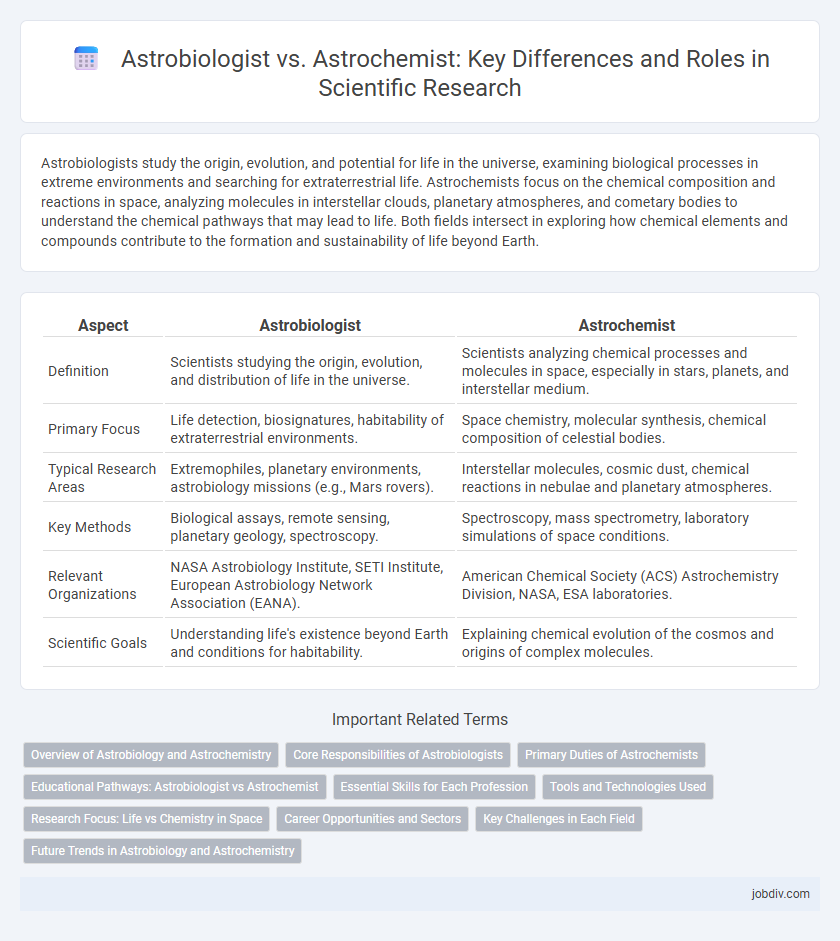Astrobiologists study the origin, evolution, and potential for life in the universe, examining biological processes in extreme environments and searching for extraterrestrial life. Astrochemists focus on the chemical composition and reactions in space, analyzing molecules in interstellar clouds, planetary atmospheres, and cometary bodies to understand the chemical pathways that may lead to life. Both fields intersect in exploring how chemical elements and compounds contribute to the formation and sustainability of life beyond Earth.
Table of Comparison
| Aspect | Astrobiologist | Astrochemist |
|---|---|---|
| Definition | Scientists studying the origin, evolution, and distribution of life in the universe. | Scientists analyzing chemical processes and molecules in space, especially in stars, planets, and interstellar medium. |
| Primary Focus | Life detection, biosignatures, habitability of extraterrestrial environments. | Space chemistry, molecular synthesis, chemical composition of celestial bodies. |
| Typical Research Areas | Extremophiles, planetary environments, astrobiology missions (e.g., Mars rovers). | Interstellar molecules, cosmic dust, chemical reactions in nebulae and planetary atmospheres. |
| Key Methods | Biological assays, remote sensing, planetary geology, spectroscopy. | Spectroscopy, mass spectrometry, laboratory simulations of space conditions. |
| Relevant Organizations | NASA Astrobiology Institute, SETI Institute, European Astrobiology Network Association (EANA). | American Chemical Society (ACS) Astrochemistry Division, NASA, ESA laboratories. |
| Scientific Goals | Understanding life's existence beyond Earth and conditions for habitability. | Explaining chemical evolution of the cosmos and origins of complex molecules. |
Overview of Astrobiology and Astrochemistry
Astrobiology explores the origin, evolution, and potential distribution of life in the universe by studying extreme environments on Earth and analyzing extraterrestrial samples. Astrochemistry investigates the chemical composition, reactions, and processes occurring in interstellar space, molecular clouds, and planetary atmospheres that contribute to the formation of complex organic molecules. Both fields intersect in examining the chemical precursors of life and the conditions essential for habitability beyond Earth.
Core Responsibilities of Astrobiologists
Astrobiologists specialize in studying the origin, evolution, and distribution of life in the universe, analyzing extreme environments on Earth to understand potential habitats on other planets. Their core responsibilities include investigating biosignatures, conducting field research in extreme terrestrial environments, and collaborating with planetary scientists to interpret data from space missions. They integrate biology, chemistry, and geology to assess habitable conditions and the potential for extraterrestrial life.
Primary Duties of Astrochemists
Astrochemists primarily analyze the chemical compositions and reactions occurring in space, focusing on molecular processes within interstellar clouds, star-forming regions, and planetary atmospheres. They use spectroscopy and laboratory simulations to identify organic molecules, isotopic ratios, and reaction pathways that contribute to the origins of life and planetary development. Their research bridges chemistry and astronomy, providing crucial insights into the molecular complexity of the cosmos.
Educational Pathways: Astrobiologist vs Astrochemist
Astrobiologists typically pursue degrees in biology, chemistry, or earth sciences, often advancing to specialized graduate programs that integrate planetary science and molecular biology. Astrochemists focus on chemistry and physics, obtaining advanced education in molecular spectroscopy, quantum chemistry, and astrochemical modeling through master's and doctoral studies. Both fields demand strong interdisciplinary training but diverge in curricular emphasis, with astrobiology prioritizing biological systems and astrochemistry emphasizing chemical processes in space.
Essential Skills for Each Profession
Astrobiologists require expertise in biology, planetary science, and environmental chemistry to investigate the origins and potential for life beyond Earth. Astrochemists specialize in chemical processes in space, necessitating skills in spectroscopy, molecular physics, and analytical chemistry. Both professions demand proficiency in data analysis, laboratory techniques, and interdisciplinary collaboration to interpret extraterrestrial materials and environments effectively.
Tools and Technologies Used
Astrobiologists utilize space telescopes, planetary rovers, and bioinformatics software to analyze potential extraterrestrial life and habitable environments. Astrochemists employ mass spectrometers, nuclear magnetic resonance (NMR) spectroscopy, and vacuum ultraviolet (VUV) photolysis to study the chemical composition and reactions of molecules in space. Both fields leverage advanced instrumentation like synchrotron radiation sources and computer modeling to simulate and investigate cosmic phenomena at molecular and biological levels.
Research Focus: Life vs Chemistry in Space
Astrobiologists concentrate on studying the origins, evolution, and potential existence of life beyond Earth, examining biosignatures and habitable environments in space. Astrochemists focus on the chemical composition, reactions, and processes occurring in interstellar mediums, comets, and planetary atmospheres to understand molecular formation in space. Both disciplines intersect in exploring the chemical foundations necessary for life, but astrobiology emphasizes biological implications while astrochemistry prioritizes molecular and atomic interactions.
Career Opportunities and Sectors
Astrobiologists primarily find career opportunities in space agencies like NASA, academic research institutions, and astrobiology-focused universities, where they study the origin, evolution, and possibility of life beyond Earth. Astrochemists, on the other hand, are often employed in laboratories within pharmaceuticals, aerospace industries, and planetary science research centers, analyzing chemical compositions of celestial bodies to understand molecular processes in space. Both fields offer interdisciplinary roles in government-funded research projects, planetary exploration missions, and astrobiology startups focusing on space colonization and biotechnology applications.
Key Challenges in Each Field
Astrobiologists face key challenges such as detecting biosignatures on distant exoplanets and understanding the origin and evolution of life in extreme environments. Astrochemists encounter difficulties in identifying complex organic molecules in interstellar space and elucidating chemical pathways under low-temperature and low-density conditions. Both fields require advanced instrumentation and interdisciplinary approaches to overcome the limitations imposed by observational and experimental constraints.
Future Trends in Astrobiology and Astrochemistry
Future trends in astrobiology emphasize the integration of advanced genomic sequencing and robotic exploration to detect biosignatures on exoplanets, enhancing the search for extraterrestrial life. Astrochemistry is progressing through the development of sophisticated spectroscopic techniques and quantum chemical simulations to better understand the formation of complex organic molecules in interstellar space. The convergence of astrobiology and astrochemistry, driven by collaborative data from space missions like the James Webb Space Telescope and Mars Sample Return, is propelling breakthroughs in identifying the chemical precursors to life beyond Earth.
Astrobiologist vs Astrochemist Infographic

 jobdiv.com
jobdiv.com